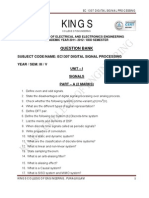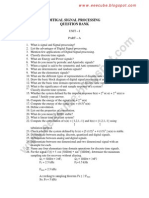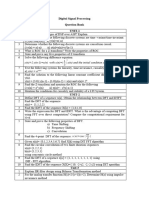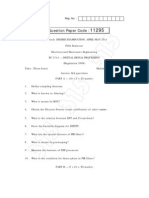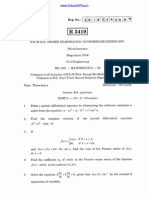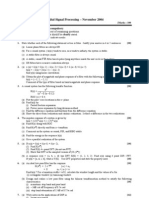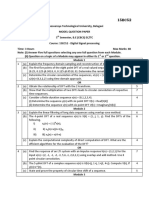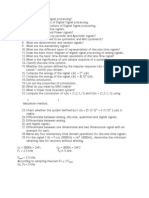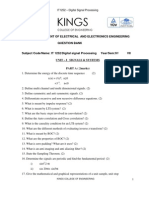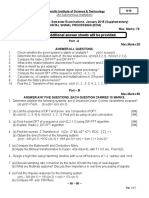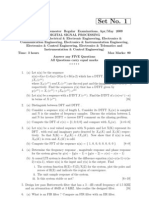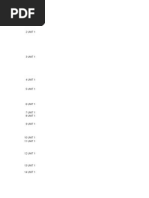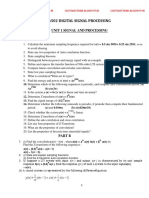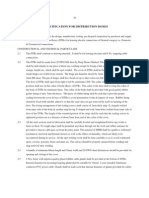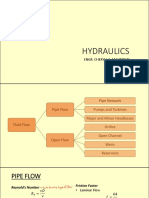100%(1)100% found this document useful (1 vote)
125 viewsCS331 Digital Signal Processing Nov Dec 2005
This document appears to be an exam for a Digital Signal Processing course, consisting of 16 multi-part questions testing various concepts in DSP. The questions cover topics such as z-transforms, DFT, FIR and IIR filters, sampling rate conversion, linearity properties, and FFT algorithms. Students are asked to determine transfer functions, realize filter structures, perform convolutions in both time and z-domain, compute the DFT, explain design methods, and analyze upsampling and decimation systems.
Uploaded by
Chandru SekarCopyright
© © All Rights Reserved
Available Formats
Download as PDF, TXT or read online on Scribd
100%(1)100% found this document useful (1 vote)
125 viewsCS331 Digital Signal Processing Nov Dec 2005
This document appears to be an exam for a Digital Signal Processing course, consisting of 16 multi-part questions testing various concepts in DSP. The questions cover topics such as z-transforms, DFT, FIR and IIR filters, sampling rate conversion, linearity properties, and FFT algorithms. Students are asked to determine transfer functions, realize filter structures, perform convolutions in both time and z-domain, compute the DFT, explain design methods, and analyze upsampling and decimation systems.
Uploaded by
Chandru SekarCopyright
© © All Rights Reserved
Available Formats
Download as PDF, TXT or read online on Scribd
You are on page 1/ 4
4225
B. E.IB.TECh. DEGREE EXAMINATION, NOVEMB ER/DE C EMBER 2005.
Fifth Semester
Computer Science and Engineering
CS 331
-
DIGITAL SIGNAL PROCESSING
Time : Three hours
Maximum : 100 marks
Answer ALL questions.
PARTA- ( 10
x2=2Q mar ks)
1. Find the fundamental period No for g (n) =
r-i(2rn/s) '
2. Det er mi net hepol esandzer os
of H( z) , H( z) =:
'
. -
/ '
- - \ - '
I _ 22- 1 +22- 2
'
3. Check for linearity and stability of gh), g(n)
=
"l;@)
.
4. Fi nd t he si gnal eners"y of x(n)=
(; )"
u@).
5. List any two properties of Discrete Fourier Transform.
6. Calculate the multiplication reduction factor, a in computing 1024 point DFT,
is a radix-z FFT algorithm.
7. If A, B, C and D are the matrices of discrete time system, write the formula for
fi.nding transfer function.
8. Compare fixed point representation of coefficients with floating point
representation.
9. Prove that decimator is Time-varying Discrete time system.
10. List few applications of multirate systems.
w
w
w
.
M
a
a
n
a
v
a
N
.
c
o
m
11.
( i )
PARTB- ( 5x16=80mar ks)
Determine H
(z) =Y (z)/
X
(z)
for Fig. 1.
(ii)
Explain through example
(1)
Linearity
(2)
Differentiation property
of z-transform.
Fig. 1
(ii)
Realise the FIR system in
(1)
Direct form
(2)
Cascade form
H
( z) =( ,
*! ,
- ' ) [ t
*L r - ' *
! ,
- ' )
.
\ 2/ \ 24)
L2.
(a) (i)
Find the convolution of x(n)*h(n) through z-transform
method.
x( n)
=( Lr ) '
" ot
h( n)
=[ 1) "
r t r r l .
\ 4/
Or
2 4225
w
w
w
.
M
a
a
n
a
v
a
N
.
c
o
m
(b) (i )
rf hr(n)=
r+)" f ut u)-u(n
-3)l
and hr(n)
=
6(n)
-
6(n-1). Fi nd t he
\ 2)
overall ltln) for the cascaded LTI system
(FiS.
2).
Fi g. 2
(ii)
Find the inverse z-transform of H
(z)
H
(z)=
--l
.
.
/ 1 \ z
I t - ! z- ' I
\ 2)
13.
(a) (i)
Determine the signal x(n) for the given Fourier transform
X( " , *) =
" - i *' n
f or
-
n
I
w
1
n .
(ii)
Find the magnitude and phase of the system y (n) =
0.6y (n
-I) =
x(n)
at w=t r / 4.
Or
(b) (i) Find the circular convolution of x(n) @
h(n) .
x( n) =1
; 0<ns10
h( n) =( ; ) ' ' o<ns1o
(ii)
State and prove Parsaval's Theorem.
14.
(a) (i)
Draw the FFT flowchart for radix-2, DIF algorithm. Assume N
=
8.
(ii)
Compute the DFT of x(n)
"(")={l ::::;
Or
(b)
Explain the various design method of IIR filters through analog frlters.
A^225
w
w
w
.
M
a
a
n
a
v
a
N
.
c
o
m
lb.
(a)
Describe filter design and implementation
(Structure) for sampling rate
conversion sYstem.
Or
(b) (i) Test for linearity, in the case of Up-Sampler'
(ii)
Explain sampling rate conversion by rational factor
(yD).
(iii)
Consider the spectrum X
(ru)
. If the signal is decimated by factor 3,
draw the O/P sPectrum.
'T1
4 A^225
w
w
w
.
M
a
a
n
a
v
a
N
.
c
o
m
You might also like
- Digital Signal Processing - Question BankNo ratings yetDigital Signal Processing - Question Bank3 pages
- CS331 Digital Signal Processing Nov Dec 2003No ratings yetCS331 Digital Signal Processing Nov Dec 20033 pages
- Note: Answer All Questions From Part A. Answer Any Five Questions From Part BNo ratings yetNote: Answer All Questions From Part A. Answer Any Five Questions From Part B1 page
- Seventh Semester B. Tech. Degree Examination: (Answer All Questions: 5 X 2 Marks 10 Marks)No ratings yetSeventh Semester B. Tech. Degree Examination: (Answer All Questions: 5 X 2 Marks 10 Marks)2 pages
- Ect303 Digital Signal Processing, December 2023No ratings yetEct303 Digital Signal Processing, December 20233 pages
- Question Bank Unit I Part A: Ae306-Digital Signal Processing AEINo ratings yetQuestion Bank Unit I Part A: Ae306-Digital Signal Processing AEI4 pages
- CS331 Digital Signal Processing Apr May 2004No ratings yetCS331 Digital Signal Processing Apr May 20043 pages
- Btech Cse It Signals Systems 20161460440120No ratings yetBtech Cse It Signals Systems 201614604401203 pages
- Digital Signal Processing - Department of Electrical and Electronics EngineeringNo ratings yetDigital Signal Processing - Department of Electrical and Electronics Engineering12 pages
- Ect303 Digital Signal Processing, December 2023No ratings yetEct303 Digital Signal Processing, December 20233 pages
- 2017 Dec. EE307-A Signals and Systems - Ktu QbankNo ratings yet2017 Dec. EE307-A Signals and Systems - Ktu Qbank2 pages
- CS331 Digital Signal Processing Apr May 2008No ratings yetCS331 Digital Signal Processing Apr May 20083 pages
- State and Proof Any Four Properties of DFT. A/M 18 (B) Determine The DFT of The Given Sequence X (N) (L, - 1, - 1, - 1, 1, 1, 1, - 1) Using DIT FFT Algorithm. A/M 18No ratings yetState and Proof Any Four Properties of DFT. A/M 18 (B) Determine The DFT of The Given Sequence X (N) (L, - 1, - 1, - 1, 1, 1, 1, - 1) Using DIT FFT Algorithm. A/M 1819 pages
- Question Bank For Digital Signal ProcessingNo ratings yetQuestion Bank For Digital Signal Processing11 pages
- Student Solutions Manual to Accompany Economic Dynamics in Discrete Time, secondeditionFrom EverandStudent Solutions Manual to Accompany Economic Dynamics in Discrete Time, secondedition4.5/5 (2)
- Logical progression of twelve double binary tables of physical-mathematical elements correlated with scientific-philosophical as well as metaphysical key concepts evidencing the dually four-dimensional basic structure of the universeFrom EverandLogical progression of twelve double binary tables of physical-mathematical elements correlated with scientific-philosophical as well as metaphysical key concepts evidencing the dually four-dimensional basic structure of the universeNo ratings yet
- Tamil Ilakkiya Varalaru Mohana Sundari Tnpsctamil - in PDF89% (9)Tamil Ilakkiya Varalaru Mohana Sundari Tnpsctamil - in PDF41 pages
- 9th Tamil Notes Thillaiyadi Valliyammai TTSM Materials PDFNo ratings yet9th Tamil Notes Thillaiyadi Valliyammai TTSM Materials PDF2 pages
- 1.2b Fitting Lines With Technology Cheat SheetNo ratings yet1.2b Fitting Lines With Technology Cheat Sheet2 pages
- Root and Install CWM On Samsung Galaxy Note 8No ratings yetRoot and Install CWM On Samsung Galaxy Note 83 pages
- B.tech.-All Branches - Final Date Sheet-June 2013 IPUNo ratings yetB.tech.-All Branches - Final Date Sheet-June 2013 IPU5 pages
- Borang Permohonan Perkhidmatan Ucc - Update 15 Ogos 2022No ratings yetBorang Permohonan Perkhidmatan Ucc - Update 15 Ogos 20224 pages
- CV+Portofolio+Testimony - Ricky Ernest - Batam - CompressedNo ratings yetCV+Portofolio+Testimony - Ricky Ernest - Batam - Compressed14 pages
- Details of Advertisement and General TermsNo ratings yetDetails of Advertisement and General Terms5 pages
- Motional Feedback On A Loudspeaker WooferNo ratings yetMotional Feedback On A Loudspeaker Woofer122 pages
- Letter To District Collectors On Data Discrepancies in BOP APPNo ratings yetLetter To District Collectors On Data Discrepancies in BOP APP3 pages
- Note: Answer All Questions From Part A. Answer Any Five Questions From Part BNote: Answer All Questions From Part A. Answer Any Five Questions From Part B
- Seventh Semester B. Tech. Degree Examination: (Answer All Questions: 5 X 2 Marks 10 Marks)Seventh Semester B. Tech. Degree Examination: (Answer All Questions: 5 X 2 Marks 10 Marks)
- Question Bank Unit I Part A: Ae306-Digital Signal Processing AEIQuestion Bank Unit I Part A: Ae306-Digital Signal Processing AEI
- Digital Signal Processing - Department of Electrical and Electronics EngineeringDigital Signal Processing - Department of Electrical and Electronics Engineering
- State and Proof Any Four Properties of DFT. A/M 18 (B) Determine The DFT of The Given Sequence X (N) (L, - 1, - 1, - 1, 1, 1, 1, - 1) Using DIT FFT Algorithm. A/M 18State and Proof Any Four Properties of DFT. A/M 18 (B) Determine The DFT of The Given Sequence X (N) (L, - 1, - 1, - 1, 1, 1, 1, - 1) Using DIT FFT Algorithm. A/M 18
- Student Solutions Manual to Accompany Economic Dynamics in Discrete Time, secondeditionFrom EverandStudent Solutions Manual to Accompany Economic Dynamics in Discrete Time, secondedition
- Geometric functions in computer aided geometric designFrom EverandGeometric functions in computer aided geometric design
- Logical progression of twelve double binary tables of physical-mathematical elements correlated with scientific-philosophical as well as metaphysical key concepts evidencing the dually four-dimensional basic structure of the universeFrom EverandLogical progression of twelve double binary tables of physical-mathematical elements correlated with scientific-philosophical as well as metaphysical key concepts evidencing the dually four-dimensional basic structure of the universe
- Tamil Ilakkiya Varalaru Mohana Sundari Tnpsctamil - in PDFTamil Ilakkiya Varalaru Mohana Sundari Tnpsctamil - in PDF
- 9th Tamil Notes Thillaiyadi Valliyammai TTSM Materials PDF9th Tamil Notes Thillaiyadi Valliyammai TTSM Materials PDF
- B.tech.-All Branches - Final Date Sheet-June 2013 IPUB.tech.-All Branches - Final Date Sheet-June 2013 IPU
- Borang Permohonan Perkhidmatan Ucc - Update 15 Ogos 2022Borang Permohonan Perkhidmatan Ucc - Update 15 Ogos 2022
- CV+Portofolio+Testimony - Ricky Ernest - Batam - CompressedCV+Portofolio+Testimony - Ricky Ernest - Batam - Compressed
- Letter To District Collectors On Data Discrepancies in BOP APPLetter To District Collectors On Data Discrepancies in BOP APP



